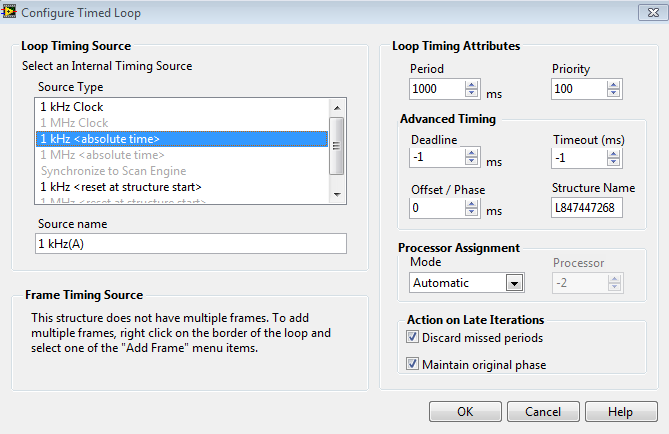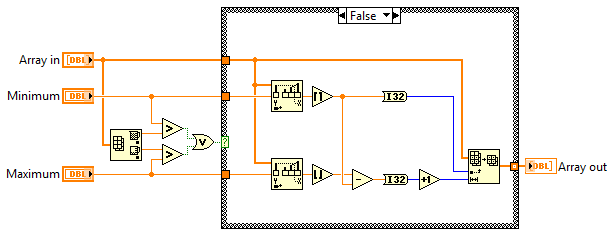-
Posts
297 -
Joined
-
Last visited
-
Days Won
10
Content Type
Profiles
Forums
Downloads
Gallery
Posts posted by eberaud
-
-
-
Our data logging engine is based on a timed loop, and the Actual Start left node is used to log the current absolute time. 99% of the time it works perfectly, but once in while it will give the value 11/11/1903 10:57:12.702 PM. Each time it gives an erroneous value, it's this exact value. Has any of you ever seen that? We use LV2011 32bit.
-
Initially it didn't do much more than transforming a variant that was a pretty exact representation of the target data.
Yes this is what I thought the whole functionality was. Thanks.
-
+1 for Register
-
I mean the Reshape array that takes a variant as an input and generates another variant as the output, the data manipulation happening on the type descriptor side. The OpenG lib seems to be a bit old, plus you said that it sometimes perform 10 times slower than the LV lib. So I try to avoid it when I can...
-
It also makes me think of a DVR (Data Value Reference). So an acronym like SEP seems appropriate.
-
I see. One thing that still requires OpenG though is the reshape array functions (MultiD --> 1D and 1D --> MultiD). Are you aware of any native LV code to replace those?
-
It's a good idea to set the post as "Answered" and define which post is the answer, so that other users seeing this thread can go directly to the solution

-
-
Same thing, my quickly jotted notes are the sparks that revives the fire in the morning
-
The OpenG does have feature that the NI lvlib doesn't though, like getting the values of the elements of an array. The lvlib GetArrayInfo.vi only gives the element type of the array. So my code uses OpenG when necessary, and VariantType.lvlib when possible, in order to use as much native NI code as possible.
-
Great, so I can focus on the lvlib only. Thanks for the info

-
I always have a draft notebook and a pen next to my keyboard. If I need to stop what I am doing because of an agenda constraint, I usually write down a few words that will remind me where to resume my work the next morning. Not super environment-friendly but that way I don't need to leave the PC on all night with the current VI opened...
-
I'm really interested in is preserving my LabVIEW.ini settings across systems. Mostly for the quick drop shortcuts
I recently installed some MGI quickdrop shortcuts, but can't find related changes to LabVIEW.ini. What settings are you talking about in this case?
-
That's what we call a visionary!
-
Reviving this topic instead of creating one... vi.lib\Utility\VariantDataType\VariantType.lvlib seems to be similar to vi.lib\Utility\GetType.llb
Is there a reason for both to exist? Is there an old implementation (the llb) and a new implementation (the lvlib)?
This whole concept seems very important to understand, I would like to get to the bottom of this.
Thanks
-
Is LuaVIEW going to support Lua 5.1 or higher at some point? I read that LuaVIEW 2.0 was in the making, but that post is 2 years old, and the LuaVIEW website shows that 1.2.2 is the latest version, and uses Lua 5.0. I'm not using Lua for now, so this is not a request, I'm just trying to understand what is going on

Edit: sorry to post about LuaVIEW in the MLua thread, the thing is that I'm quoting a post about LuaVIEW that was posted here...
-
Resolved by downloading CCT 2.1.3-1 and installing that package first from the product homepage. VIPM was scessful in installing 3.2.1-46 as an upgrade
I ran into the same conflict issue, so I tried to find version 2.1.3-1 and let VIPM upgrade it but I can't find this version. The earliest version 3.x I can find is 3.2.0-41 which led to the same conflict error...
-
So I'm getting a little confused here. Everything is installed in the user lib at first, which doesn't insert the "Rex - New Command" utility in the Tools menu. Moving the whole Rex folder to C:\Program Files (x86)\National Instruments\LabVIEW 2014\project\ does the trick. But now when I click on "Rex - New Command", it can't find the files it needs and seems to be looking for them in the user lib.
Long story short, what files should be where?
Thanks!
-
I wouldn't cast your objects into variant. The fact that you can have an array of the ancestor class is the whole point and beauty of OOP. What is important is how you create the object. As long as you create an object as a child class, the child overriding method - if there is one - will be called instead of the parent one when the method is called on one element of your array. For this to happen, you need dynamic dispatch of course.
I put together a quick demo of what I'm talking about.
-
-
Just spend a full hour reading about ISO 8601, UTC, the earth's rotation that is slowing down, and leap seconds. Thanks for this super interesting reading

-
I looked at it, but because it was based on linear interpolation, I was afraid this would work only if the gap between each consecutive element is the same. If you confirm I was wrong, then great, I will use the Threshold function!
-
I have an array that is already sorted. I want to find or write a VI that returns a subset of this array based on a minimum and a maximum values that I define.
For example, if the array contains [0,1,2,3,4,5] and I set min = 2.9 and max = 4.1, the function should return [3,4]. So far the only way I can think of is to take each element starting at index 0 and compare it to the minimum. When I find a value that is greater than the minimum, I start comparing each following element to the maximum. When a value is greater than the maximum, I can stop the execution and return what I have collected. Although this would work, it seems light-years away from being optimized... I can't find any LabVIEW or OpenG functions that does this.
I can't use the Search function since the minimum and maximum values might not match any element in the array...
Ideas appreciated








Error -2539 trying to open multiple references to the same TDMS file with the Advanced TDMS palette.
in Database and File IO
Posted
Hi, I struggled quite a bit with it too but now everything works really nice, so let's see if I can help. There is a disable structure, should I look at the enable or disable case? In case it's the enable one, can you make a simplified version that has all the TDMS code in one VI and demonstrates what you're trying to achieve on the TDMS side only?